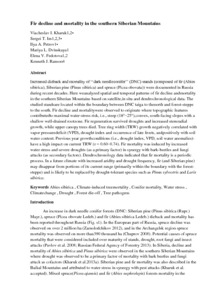Показать сокращенную информацию
Fir Decline and Mortality in the Southern Siberian Mountains
| Автор | Viacheslav I. Kharuk | |
| Автор | Sergei T. Im | |
| Автор | Ilya A. Petrov | |
| Автор | Mariya L. Dvinskaya | |
| Автор | Elena V. Fedotova | |
| Автор | Kenneth J. Ranson | |
| Дата внесения | 2018-02-07T07:27:58Z | |
| Дата, когда ресурс стал доступен | 2018-02-07T07:27:58Z | |
| Дата публикации | 2017 | |
| Библиографическое описание | Viacheslav I. Kharuk. Fir Decline and Mortality in the Southern Siberian Mountains [Текст] / Viacheslav I. Kharuk, Sergei T. Im, Ilya A. Petrov, Mariya L. Dvinskaya, Elena V. Fedotova, Kenneth J. Ranson // Regional Environmental Change. — 2017. — Т. 17 (№ 3). — С. 803-812 | |
| ISSN | 14363798 | |
| URI (для ссылок/цитирований) | https://link.springer.com/article/10.1007/s10113-016-1073-5 | |
| URI (для ссылок/цитирований) | https://elib.sfu-kras.ru/handle/2311/69764 | |
| Описание | Текст статьи не публикуется в открытом доступе в соответствии с политикой журнала. | |
| Аннотация | Increased dieback and mortality of ‘‘dark needle conifer’’ (DNC) stands (composed of fir (Abies sibirica), Siberian pine (Pinus sibirica) and spruce (Picea obovata)) were documented in Russia during recent decades. Here we analyzed spatial and temporal patterns of fir decline and mortality in the southern Siberian Mountains based on satellite, in situ and dendrochronological data. The studied stands are located within the boundary between DNC taiga to the north and forest-steppe to the south. Fir decline and mortality were observed to originate where topographic features contributed to maximal water-stress risk, i.e., steep (18–25deg), convex, south-facing slopes with a shallow well-drained root zone. Fir regeneration survived droughts and increased stem radial growth, while upper canopy trees died. Tree ring width (TRW) growth negatively correlated with vapor pressure deficit(VPD), drought index and occurrence of late frosts, and positively with soil water content. Previous year growth conditions (i.e., drought index, VPD, soil water anomalies) have a high impact on current TRW (r = 0.60–0.74). Fir mortality was induced by increased water stress and severe droughts (as a primary factor) in synergy with bark-beetles and fungi attacks (as secondary factors). Dendrochronology data indicated that fir mortality is a periodic process. In a future climate with increased aridity and drought frequency, fir (and Siberian pine) may disappear from portions of its current range (primarily within the boundary with the forest steppe) and is likely to be replaced by drought-tolerant species such as Pinus sylvestris and Larix sibirica. | |
| Тема | Abies sibirica | |
| Тема | Climate-induced tree mortality | |
| Тема | Conifer mortality | |
| Тема | Water stress | |
| Тема | Climate change | |
| Тема | Drought | |
| Тема | Forest die-off | |
| Тема | Tree pathogens | |
| Название | Fir Decline and Mortality in the Southern Siberian Mountains | |
| Тип | Journal Article | |
| Тип | Published Journal Article | |
| Страницы | 803-812 | |
| ГРНТИ | 34.35.25 | |
| Дата обновления | 2018-02-07T07:27:58Z | |
| DOI | 10.1007/s10113-016-1073-5 | |
| Институт | Институт космических и информационных технологий | |
| Институт | Институт экологии и географии | |
| Подразделение | Базовая кафедра геоинформационных систем | |
| Подразделение | Кафедра географии | |
| Журнал | Regional Environmental Change | |
| Квартиль журнала в Scopus | Q2 | |
| Квартиль журнала в Web of Science | Q1 |

